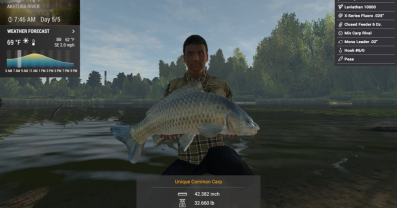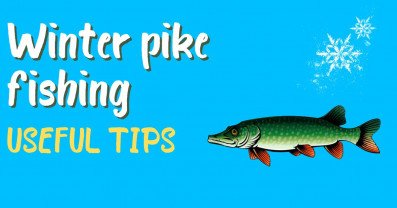Fishing River Carp: Tips and Techniques
Before we dive into the tips and techniques, let's take a moment to understand the carp's behavior in rivers. River carp is known for their strong swimming abilities and their love for hiding behind underwater structures such as rocks, logs, and vegetation. Carp feeds on various types of food such as insects, worms, and crustaceans. However, their favorite food is plant matter like seeds and leaves. It's important to keep this in mind when selecting your bait.
Best Time to Fish for River Carp
The best time to fish for river carp is during the early morning and late evening hours. During these hours, carp tends to be more active and feeding near the surface. You should also consider the weather conditions. Carp fishing is more productive on cloudy and overcast days compared to sunny days. Carp also prefers calm waters, so avoid fishing on windy days.
Finding a Spot
Before you start looking for a spot, it's essential to understand the habitat of river carp. Carp thrive in slow-moving or still waters such as canals, ponds, and rivers with little current. They prefer shallow water with a muddy bottom, aquatic vegetation, and structures like fallen trees or rocks. Carp also like to congregate near overhanging trees or under bridges, where they can find shade and protection.
Identifying Carp Feeding Areas
Carp are opportunistic feeders, so finding their feeding areas is crucial. Look for areas with visible signs of feeding, such as bubbles, mud plumes, or surface disturbances. You can also use a fish finder to locate the carp's food source, such as weed beds or snags. Once you've found the feeding areas, mark them on your map for future reference.
Using Weather Conditions to Your Advantage
Weather conditions play a vital role in carp fishing, so make sure to check the weather forecast before you head out. Carp tend to be more active during warmer weather and overcast days. On sunny days, they may stay in deeper waters to avoid the heat. Windy conditions can create a natural current, which can lead carp to congregate in certain areas. As an option we suggest to use our fishing forecast where you can predict fishing biting on your favourite reservoir.
Feed a chosen Spot
When fishing outside of hand-feeding range you’d like to use a spod, but you need to be aware of the depth and flow into which you are casting and take this into consideration when casting out to ensure that your feed is arriving in the proper location. In a right-to-left flow, spod more to the right of where you want to cast so the bait lands over the target region. If you don't have a boat and you’re fishing closer to shore, use a catapult.
Use right Bite
There are several types of baits that you can use to catch river carp. Carp are opportunistic feeders, so you can try using different types of bait to see what works best for you. Some of the most effective baits for river carp include boilies, pellets, sweetcorn, bread, and maggots. You can also try using flavored or scented baits to attract carp. It's important to remember that carp can be picky eaters, so it's a good idea to experiment with different baits until you find one that works.
Boilies
Baits work best for catching carp when fishing in rivers. Boilies are a concoction of diverse flavors, colors, and scents that are intended to entice carp.This bait is especially successful when carp are in shallow water and can be fished on the bottom or suspended just off the bottom.
Pellets
Pellets are a popular bait for catching river carp because they are easy to use and can be very effective. Here are some tips on how to use pellets to catch carp:
- Choose the right type of pellet: There are many different types of pellets available, but the most popular ones for carp fishing are halibut pellets and trout pellets. Halibut pellets are larger and have a stronger smell, while trout pellets are smaller and less pungent. Both types can be effective, but you may want to experiment to see which type works best for you.
- Prepare your pellets: Before you go fishing, you'll need to prepare your pellets. Most pellets need to be soaked in water for several hours to soften them and make them more attractive to carp. You can also add flavorings or attractants to your pellets to make them even more appealing.
Sweetcorn
Sweetcorn is a classic bait for catching river carp, and it's easy to use and widely available. Here are some tips on how to use sweetcorn to catch carp:
- Choose the right size and color: You can use either canned sweetcorn or fresh sweetcorn, but canned sweetcorn is usually easier to use and more consistent in terms of size and texture. Choose a bright yellow or white color, as this is most likely to attract the attention of carp.
- Prepare your bait: You can use sweetcorn straight out of the can, but it's often more effective to add flavorings or attractants to your bait. You can use a variety of flavorings, including honey, vanilla, and chili powder, or you can use specialized carp attractants that are available from fishing stores.
Bread
Bread is a simple and effective bait for catching river carp, and it's a favorite among many anglers. Here are some tips on how to use bread to catch carp:
- Choose the right type of bread: The best type of bread for carp fishing is plain white bread. Avoid bread with seeds or other additives, as these can make it harder to form the bread into the right shape and texture.
- Prepare your bait: To prepare your bread bait, you'll need to remove the crusts and knead the bread into a ball. You can also add flavorings or attractants to your bread, such as vanilla or cinnamon, to make it more appealing to carp.
Maggots
Maggots are a popular bait for river carp fishing and can be highly effective. Here are some tips on how to use maggots to catch carp:
- Choose the right maggots: When using maggots as bait for carp fishing, it's important to choose the right size and color. Typically, anglers use white maggots that are about 8-10mm in length. You can also use red maggots, which are often more effective in colored water.
- Prepare your maggots: Before using maggots as bait, they need to be prepared. To do this, place the maggots in a container with a small amount of water and add some maize flour or cereal to the container to keep them fresh. You can also add attractants or flavorings to the container, such as chili powder or vanilla extract.
Rigs to use
When it comes to carp fishing, the rig you choose can make a big difference in your success. Here are some popular rigs that can be used to catch river carp:
Hair rig
The hair rig is one of the most popular rigs for carp fishing, and it involves attaching the bait to a separate piece of line or hair, which is then attached to the hook. This allows the bait to move freely, making it more attractive to the fish.
Bolt rig
The bolt rig is designed to set the hook quickly when the carp takes the bait. This rig involves a large lead weight that sits on the lake bed, with the bait attached to a short hook length. When the carp takes the bait, the weight pulls the hook into the fish's mouth, setting the hook.
Chod rig
The chod rig is a popular rig for fishing in weedy or snaggy areas. It involves a short hook length attached to a curved section of stiff mono or fluorocarbon, which is then attached to the main line with a swivel. This rig allows the bait to sit on top of the weeds or debris, making it more visible to the fish.
Zig rig
The zig rig is a floating rig that is designed to fish at different depths. This rig involves a buoyant hook bait, such as foam or a piece of pop-up corn, attached to a long hook length. The length of the hook length determines the depth at which the bait will float.
There are many other rigs that can be used to catch river carp, but these are some of the most popular and effective. The rig you choose will depend on the conditions and the type of bait you are using.
Is PVA effective?
PVA can be very effective for catching river carp, as it allows anglers to deliver bait to specific areas of the river. By using PVA bags or mesh, anglers can present their bait in a way that is attractive to the fish, increasing the chances of a bite. PVA bags are particularly useful when fishing in fast-flowing rivers, as they help to keep the bait in one place and prevent it from being washed away by the current.
It's important to note that PVA can be harmful to the environment if not used correctly. Anglers should always dispose of PVA bags and mesh properly, and should avoid using excessive amounts of PVA in the river. By using PVA responsibly and in moderation, anglers can enjoy the benefits of this effective carp fishing tool while minimizing its impact on the environment.
Conclusion
Fishing for river carp can be a challenging but enjoyable experience. Understanding their behavior, selecting the right equipment and bait, and using proper techniques can increase your chances of a successful catch. Remember to stay safe and have fun while enjoying the beauty of nature..
FAQs
What is the best bait for river carp fishing?
Carp feeds on various types of food such as insects, worms, and crustaceans. However, their favorite food is plant matter like seeds and leaves. Flavored corn or maize, boilies, and pellets can be effective bait options.
What time of day is best for river carp fishing?
Early morning and late evening hours are the best times for carp fishing in rivers.
What kind of rod is recommended for river carp fishing?
A medium to heavy power rod with a strong backbone is recommended for catching river carp.



